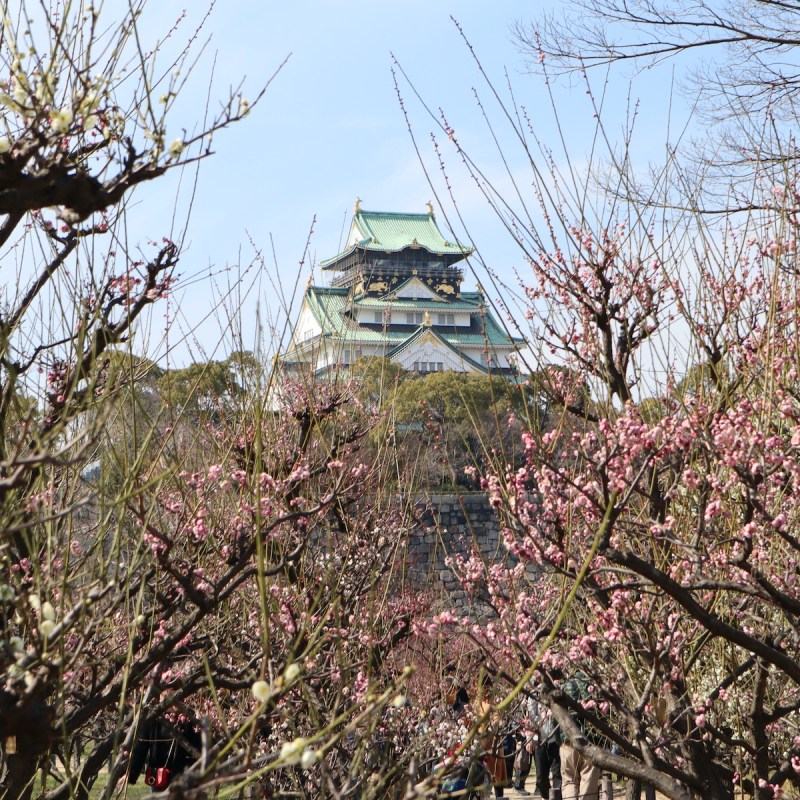
Cherry blossoms are a symbol of spring, and the season attracts thousands of visitors to Japan each year to see blossoming trees surrounding castles and temples and to walk under masses of pink petals in parks. With all the attention given to cherry blossoms, visitors often don’t know about Japan’s plum blossoms — which are just as beautiful. They are the first sign of spring, flowering earlier than cherry blossoms.
Videos by TravelAwaits
Plum blossoms have a long history in Japan from when they were introduced from China centuries ago. They traditionally symbolize good fortune and were planted around shrines to ward off evil. The plum blossom has been featured in traditional Japanese paintings, and the five round petals of the plum blossom are a popular motif that appears in decorative art.
After their introduction to Japan, different plum varieties developed with flowers ranging from white to deep pink. This range of colors creates spectacular displays in parks and gardens around Japan.
Although the cherry blossom season is better known to international visitors, I enjoyed visiting Japan during the plum blossom season. There are several reasons why the plum blossom season is a rewarding time to visit Japan.

1. Beat The Crowds
Cherry blossom season can be hectic in the popular tourist destinations of Tokyo and Kyoto, as domestic and international tourists throng prime viewing spots. Plum blossoms flower from mid-February to mid-March, earlier than cherry blossoms which flower from mid-March to mid-April. This means it’s shoulder season in terms of travel costs and crowds. Hotels are at their most expensive during cherry blossom season and get booked out fast. Earlier in spring, you’ll have a greater choice of accommodation at a more reasonable cost and you can enjoy beautiful plum blossoms without being overcrowded.
Pro Tip: The weather is still a bit chilly early in spring and viewing plum blossoms means spending a lot of time outdoors, so be prepared with a warm jacket. The days are generally fine with blue skies at this time of year, but there may be an occasional shower.
2. Fragrant Flowers
The sweet fragrance of plum blossom drifts through plum orchards during blossom season, adding to the pleasure of strolling through the trees. You may even smell the blossoms before you see the trees. Although plum blossoms and cherry blossoms look similar with masses of pink flowers, cherry blossoms lack fragrance.
Some of the larger plum blossom spots have seating areas with tea and snack stands. These are great for a rest break where you can enjoy the fragrance while looking at the blossoms.

3. Bonsai
Plum bonsai look so cute with full-sized flowers massed on gnarled branches. The miniaturized trees are only about 15 to 20 inches high and are carefully trained into artistic shapes. This process takes a long time, with some trees hundreds of years old, but it results in some amazingly beautiful bonsai.
I have come across bonsai exhibitions as part of plum blossom festivals at shrines and in parks. If you want to be certain of seeing plum bonsai, another option is to visit the Omiya Bonsai Art Museum near Tokyo. Here you can see displays of seasonal bonsai and learn about the techniques behind this art form.
Pro Tip: The recommended way to view a bonsai is to look at the roots first, then upwards to the trunk, and finally the branches, foliage, and flowers.
4. Seasonal Souvenirs
Every year, stores sell cherry blossom season limited edition items as varied as Pocky candy and Citizen watches. International brands also get into the spirit of the season with Lindt selling cherry blossom chocolate and Starbucks offering themed tumblers and drink flasks, exclusive to their stores in Japan. The limited edition goods are typically available from early spring onwards, so you will get an excellent selection of cherry blossom souvenirs to choose from. Very popular items can sell out fast, meaning it is an advantage to be there earlier in spring.

5. Early Cherry Blossom
If you’ve always dreamed of seeing cherry blossoms in Japan, you will still be able to see this during plum blossom season. Just as there are many varieties of plum blossom, there are many varieties of cherry blossom too. Some bloom very early in the season, in February — around the same time as plum blossoms.
Early cherry blossoms can be found in many large city parks, such as Shinjuku Gyoen and Ueno Park in Tokyo. Often there will be crowds around the trees, as people take selfies surrounded by cherry blossoms.
Pro Tip: While you can often guess which is the early flowering cherry blossom by the crowds around the trees, look closely at the petals to check whether it’s plum or cherry. Plum blossoms have round petals, while cherry blossom petals are oval with a notch at the tip.

Best Places To See Plum Blossom
You can see plum blossoms at many parks and historic buildings throughout Japan, but there are some landmark plum blossom spots that are worth making a special trip to see. Hundreds of plum trees massed together are a spectacular sight during blossom season. Here are some of the best places to see plum blossoms.
Kairakuen
A dusting of pink and white spreads across the park, contrasting with the formal clipped shrubs. Kairakuen has over 3,000 plum trees, and the best view is from Kobuntei, a traditional Japanese house in the center of the garden. It’s worth paying the modest entry fee to climb the stairs to the upper floors and look out over the treetops. The tranquil view takes in the garden and nearby Senba Lake, with the city of Mito in the background.

While there are many beautiful gardens in Japan, there are three gardens acknowledged as the best landscape gardens in Japan. Kairakuen is one of these, and it’s less than 2 hours by train from Tokyo. The garden has year-round appeal, with wisteria, bamboo, azaleas, and other plants, but it is most famous for its plum trees. With over 100 varieties of plums planted in the garden, the blossom season extends from mid-February to late March.
Pro Tip: Kairakuen’s plum blossom festival runs throughout the blossom season with extra events at the weekends. It features cultural performances, food stalls, and evening illuminations. Plum blossom festivals, or ume matsuri in Japanese, are held in other places throughout Japan and it’s worth looking out for them in your travels.

Kitano Tenmangu Shrine
Kyoto’s Kitano Tenmangu shrine is an impressive sight, with its historic buildings ornamented with vivid gold and vermilion details. It’s often busy with worshippers who’ve come to pray, clapping their hands and ringing the shrine bells to get the attention of the shrine’s deities. Plum trees are dotted throughout the grounds, adding even more color when they bloom.
Walking to the rear of the shrine brings you to the most spectacular sight. From the top of a hill, you look down onto an orchard of 1,500 plum trees and then follow a path downhill to walk among the trees. There is an entry charge for the orchard which includes green tea and a Japanese sweet, so you can rest in the orchard for a while to enjoy the blossom.
Tenmangu shrines in other cities throughout Japan all feature plum trees, which are traditionally associated with the god Tenjin. Yushima Tenmangu in Tokyo and Dazaifu Tenmangu in Fukuoka are also great spots to visit during plum blossom season.

Pro Tip: On February 25 every year, Kitano Tenmangu holds an event called Baikasai, where local geisha apprentices perform a tea ceremony that the public can attend. Even if you don’t manage to get the highly sought-after tickets, you can see the geisha arriving at the shrine before the ceremony starts at 10 a.m. They are dressed in beautiful kimonos with elaborate plum-themed hair ornaments.
Osaka Castle Park
A traditional white castle framed by pink blossoms is an iconic image of Japan, and Osaka Castle is a well-known cherry blossom spot with its pristine white walls rising above the park. On the other side of the castle, the plum grove lies between the inner and outer moats. More than 1,200 trees start blooming from early spring onwards, creating that iconic image of a castle surrounded by blossoms, but in shades ranging from white to deep pink.
Unlike the cherry blossom garden, entry to the plum grove is free. It’s also possible to visit the museum inside the castle or take a boat trip along the moat, both requiring an entry charge. Osaka Castle Park is easily reached by public transit, with flat paths from Osaka Castle Park Station leading to the plum blossom grove. Refreshments are available in the plum grove during blossom season, so you can buy a snack and sit for a while to enjoy the plum blossoms.
